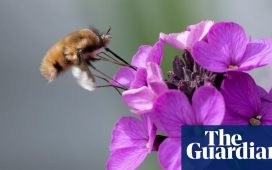When Marven Robinson was a kid, any mention of spirit bears was met with hushed dismissal from the elders in his community, the Gitga’at First Nation of Hartley Bay, British Columbia. Since the 19th century, Indigenous peoples in the area learned to keep the bears with ghostly coats a secret to protect them from fur traders.
As the ancient legend goes, the Wee’get (meaning the “raven,” known as the creator of the world) turned every 10th black bear white to remind people of the pristine conditions of the Ice Age.
Spirit bears are white-coated black bears that inherit their pale fur from a rare recessive gene. Known as moksgm’ol, meaning “white bear”, spirit bears are sacred to the Indigenous people who live in the Great Bear Rainforest, a 6.4m-hectare swath of land in central and northern British Columbia.
Despite growing public interest in the bruins, scientific understanding of them is still nascent. But a recent collaborative study by the Kitasoo/Xai’xais and Gitga’at First Nations and academic researchers has revealed that the white bear is rarer and more vulnerable than previously thought.
Researchers spent eight years combing 18,000sq km of the rainforest, placing lures on barbed wire to collect hair samples from black and spirit bears and map out the presence of the white bear gene. While scientists had previously estimated there were anywhere between 100 to 500 white bears, the study concluded the gene that causes spirit bears is up to 50% rarer than previously thought. Urgently, about half of spirit bear hotspots fall outside of British Columbia protected areas, making their habitats vulnerable to logging, mining and drilling projects.

Spirit bears have long been present in First Nations traditional song, dance, and storytelling, but it wasn’t until 1905 that they were recognized by Western science and named Kermode bears, after Francis Kermode, former director of the British Columbia Provincial Museum. It took another century for visitors to start flocking to the rainforest to catch a glimpse of the magical white-coated bear, producing a boost of ecotourism dollars for First Nations communities. The Kermode bear was even designated British Columbia’s official mammal.
Before he saw a spirit bear for himself, Douglas Neasloss, co-author of the study and resource stewardship director for the Kitasoo/Xai’xais Nation, doubted they even existed. When he was 17, he went in search of spirit bears, half in jest, with some friends. “I just thought they were pulling my leg,” Neasloss said. “I just went for a walk. I wasn’t looking for a spirit bear.” Sure enough, as he was walking through the forest, he saw one of the magical white bears making its way toward him, sun shining through the trees, salmon hanging out of its mouth. From that moment on, he knew they had to be protected.
Neasloss helped create the Spirit Bear Lodge, constructed in 2001 in Klemtu, British Columbia, which attracts visitors from around the world to see the wildlife that inhabits the Great Bear Rainforest – including spirit bears, if they happen to get lucky.
On top of their cultural, economic and genetic significance, spirit bears, along with their black counterparts, enrich the forest by spreading marine nutrients through the transportation of salmon from the stream to the forest where they eat it, away from the more aggressive grizzly bears. Salmon provide about 80% of the trees’ nitrogen, a nutrient essential to rainforest’s survival. While this benefit is not limited to spirit bears, research by University of Victoria scientists found because of their white color, spirit bears have a unique advantage over black bears when catching salmon since they blend into the daylight.

Spirit bears’ propensity for catching salmon helps explain their resilience despite being so rare, says Christina Service, wildlife biologist for Kitasoo/Xai’xais First Nation Stewardship Authority and lead author on the spirit bear study.
Worryingly, climate change is wiping away salmon stocks, posing a big threat to bears’ food supply. British Columbia’s Pacific salmon populations have declined by over 80% since the 1990s. Neasloss says 2020 has been the worst year yet.
Equipped with new information about the vulnerability of spirit bears, the question now is how best to protect them. For Neasloss and many others who know the bears intimately, the answer is obvious: Leave it up to the First Nations, the original stewards of the land.

Much of the rainforest is protected under a 2016 agreement with the British Columbia government, but Neasloss says the current framework lacks adequate scientific grounding and First Nations insight, and leaves spirit bears vulnerable. For example, even in protected areas – which the study showed are out of sync with spirit bear hot spots – it is still legal to hunt black bears. While hunting white bears is prohibited, black bears can carry the recessive gene that produces spirit bears and is essential to the population’s survival.
Neasloss is involved in efforts to create a new land designation for the rainforest called an Indigenous Protected Area, a conservation strategy that is gaining traction across Canada. Indigenous Protected Areas give the power back to First Nations people by allowing them to use their own laws and authority to protect the lands, waters and wildlife they have lived on for centuries.
In 2018, the Edéhzhíe Protected Area in the Dehcho region of the Northwest Territories became Canada’s first Indigenous Protected Area. The land is now co-managed by the Dehcho First Nations and the Canadian government, who must make decisions by consensus, a process with roots in indigenous culture. They share a mandate to protect the land, support the relationship between the First Nations and the land, and contribute to reconciliation.
“For the last 150 years, we’ve been on the outside looking in,” Neasloss says. “Drawing a line on the map does not protect an area. The people do.”








